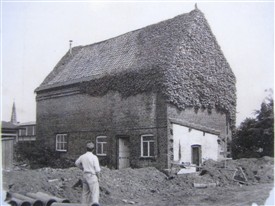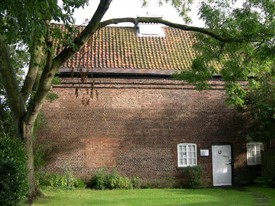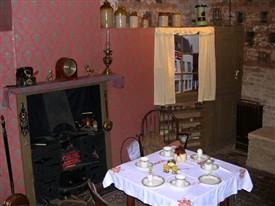Wollaton Village Dovecote Museum

Renovation

The Dovecote today

Scullery Exhibition
Wollaton Village Dovecote Museum, Dovecote Drive
A Hidden Gem
By Angela Gilbert
A hidden gem
WOLLATON VILLAGE DOVECOTE MUSEUM
Dovecote Drive, Wollaton, Nottingham, NG8 2NB
Down a quiet cul-de-sac a short walk from the centre of Wollaton Village is the 16th century Dovecote where you will step into a remarkable building and back into Wollaton history.
HISTORY OF THE DOVECOTE
Built around 1565 by Sir Francis Willoughby in fine hand-made red brick, with his initials in black brick above the main door, the Dovecote is one of the oldest buildings in the village. It is also one of the oldest dovecotes in the country. It originally stood in the middle of a field to prevent the nervous birds being disturbed.
It continued to be used as a dovecote even after Sir Francis built the “new” Wollaton Hall in 1588. By the 1880’s it had been converted into stables and three windows, a rear door and a floor had been added. However, after the sale of the Estate in 1926 it began to fall into disrepair and by the 1960’s was in danger of being demolished. A local campaign ensured its survival and it is now a Grade II listed building, owned by Nottingham City Council. It was restored by Nottingham Civic Society and is now leased to Wollaton Historical & Conservation Society and volunteers put on a variety of exhibitions in the summer months.
Surrounded as it is by modern housing, it is now difficult to fully appreciate this important building which has stood here for over 400 years.
INSIDE THE DOVECOTE
Originally there would have been no windows, floor or internal walls. Access was from the one door, which now leads to a private garden. The building is 41 ft by 21 ft with a height of 33 ft. It faces south-east to catch the early morning sun. Originally there were approximately 1,180 L-shaped nesting boxes on all four walls, sufficient for over 5,000 birds.
The doves were domesticated descendants of the rock dove, the same size and appearance as the town pigeon of today. They came and went through two glovers, an anglicised French word for “opening”, one centrally placed on the ridge and the other at the eaves. The doves foraged for themselves but, especially in winter, they were given supplementary food such as hard grain or grey peas. There would also be a supply of water and somewhere for them to bathe.
A pair of doves produced two chicks up to eight times a year, often starting a second nest before the first brood flew. From May to September the young birds, called squabs, ere a regular source of food. They were usually culled at four weeks before the breast meat was toughened by exercise. Adult birds would be eaten after long, slow cooking and were also supplied to falconers as food for their birds of prey. The feathers and down were used for bed quilts and pillows. The dung was a very valuable fertiliser and a source of saltpetre (potassium nitrate) used for making gunpowder and for tanning leather.
EXHIBITIONS
· There is a replica parlour and scullery dressed with objects and furniture from the late 1800’s to mid 1900’s.
· Regularly changing exhibitions of old photographs and plans for Wollaton through the ages.
· The history of Wollaton Dovecote and its restoration.
WOLLATON VILLAGE
At the heart of the village is the Pump with its 19th century canopy. To the east is the Admiral Rodney Public House. In its car park can be seen the old barn, formerly used as the village school. To the right of the pub is a fine terrace of 18th century houses what once housed the village shop and police station. The 13th century St Leonard’s Church contains monuments to the Willoughby family and also a memorial to Robert Smythson, described as architect of Wollaton Hall. The 14th century stone cottage opposite the church is the oldest house in the village. The Square is surrounded by two-storey 18th century cottages. In 1955 and again in 1969 applications were made to demolish them and build modern shops. The local opposition led to the founding of the Wollaton Village Preservation Society, the predecessor to Wollaton Historical and Conservation Society.
For details of the Society and the Dovecote Museum of Wollaton please contact Angela Gilbert, 0115 928 3414, e-mail Angela.gilbert@live.co.uk